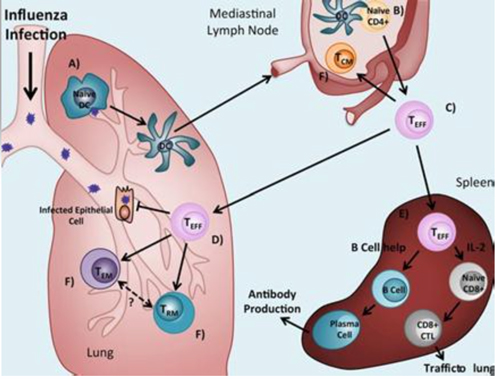CD4 T Cell Recruitment to the Lung After Influenza Infection
 Effector CD4 T cells play important roles in virus control in the respiratory tract, both directly and by coordinating responses with other immune cells. The lung is highly vascularized and recent studies have shown that a substantial fraction of antigen-specific T cells are located throughout the organ, including the pulmonary vasculature and tissue. Little is known about the abundance, distribution, and potential consequences of compartmentalization of CD4 T cells during the peak of the cellular response, which may be heavily influenced by the two microenvironments. We are currently employing a mouse model of influenza infection in conjunction with intravascular labeling in vivo, we examined the cellular heterogeneity, fine specificity, and polyfunctionality of effector CD4 T cells in pulmonary vasculature and tissue. We are also employing gene expression profiling and RNAseq to more fully understand the molecular and genetic changes associated with transition from lymph node primed CD4 T cells to resident effector CD4 T cells in the lung.
Effector CD4 T cells play important roles in virus control in the respiratory tract, both directly and by coordinating responses with other immune cells. The lung is highly vascularized and recent studies have shown that a substantial fraction of antigen-specific T cells are located throughout the organ, including the pulmonary vasculature and tissue. Little is known about the abundance, distribution, and potential consequences of compartmentalization of CD4 T cells during the peak of the cellular response, which may be heavily influenced by the two microenvironments. We are currently employing a mouse model of influenza infection in conjunction with intravascular labeling in vivo, we examined the cellular heterogeneity, fine specificity, and polyfunctionality of effector CD4 T cells in pulmonary vasculature and tissue. We are also employing gene expression profiling and RNAseq to more fully understand the molecular and genetic changes associated with transition from lymph node primed CD4 T cells to resident effector CD4 T cells in the lung.